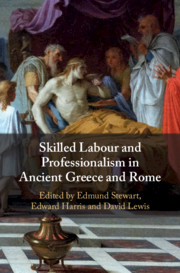Book contents
- Skilled Labour and Professionalism in Ancient Greece and Rome
- Skilled Labour and Professionalism in Ancient Greece and Rome
- Copyright page
- Contents
- Illustrations
- Contributors
- Acknowledgements
- Abbreviations
- Introduction
- Part I Professionals and Professional Identity in Greece and Rome
- Part II Specialization and the Division of Labour in the Ancient City
- Part III Case Studies of Professions 1: Sculpture
- Part IV Case Studies of Professions 2: Music and Athletics
- 9 The Profession of Mousikē in Classical Greece
- 10 Artists of Dionysus: The First Professional Associations in the Ancient Greek World
- 11 Neither Amateurs nor Professionals: The Status of Greek Athletes
- Part V Case Studies of Professions 3: A Profession of Arms?
- Index
- References
10 - Artists of Dionysus: The First Professional Associations in the Ancient Greek World
from Part IV - Case Studies of Professions 2: Music and Athletics
Published online by Cambridge University Press: 18 September 2020
- Skilled Labour and Professionalism in Ancient Greece and Rome
- Skilled Labour and Professionalism in Ancient Greece and Rome
- Copyright page
- Contents
- Illustrations
- Contributors
- Acknowledgements
- Abbreviations
- Introduction
- Part I Professionals and Professional Identity in Greece and Rome
- Part II Specialization and the Division of Labour in the Ancient City
- Part III Case Studies of Professions 1: Sculpture
- Part IV Case Studies of Professions 2: Music and Athletics
- 9 The Profession of Mousikē in Classical Greece
- 10 Artists of Dionysus: The First Professional Associations in the Ancient Greek World
- 11 Neither Amateurs nor Professionals: The Status of Greek Athletes
- Part V Case Studies of Professions 3: A Profession of Arms?
- Index
- References
Summary
By the early third century BC, musicians and people of the theatre with varied specializations, who participated in the Greek music contests (technitai tou Dionysou), began to organize themselves into associations, which can be deemed as the first professional associations in the Greek world. These associations were acting on behalf of their members as their ‘art agents’, but also on behalf of the organizers of festivals and contests (cities, kings, confederations) as their intermediaries.
- Type
- Chapter
- Information
- Skilled Labour and Professionalism in Ancient Greece and Rome , pp. 293 - 312Publisher: Cambridge University PressPrint publication year: 2020
References
- 2
- Cited by



